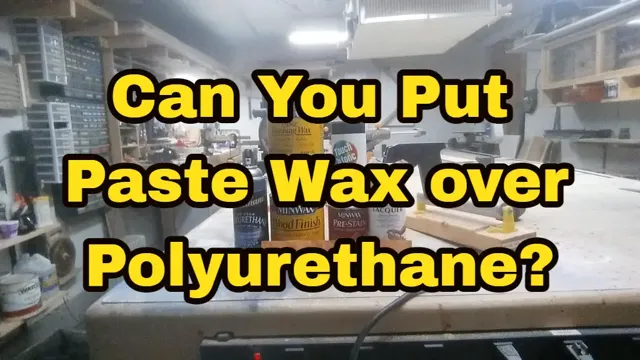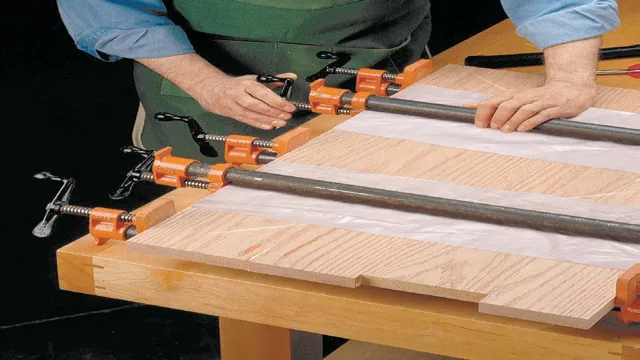Can You Wax Over Polyurethane? A Comprehensive Guide to Proper Waxing Techniques

Waxing over polyurethane can be a tricky process and many DIY enthusiasts aren’t sure whether it’s a viable option for refreshing the appearance of their wooden furniture. While polyurethane is a durable and protective sealant, it can become dull and worn over time, leaving your furniture looking lackluster. Waxing, on the other hand, can add a beautiful lustrous finish, but it’s important to understand the proper technique to ensure great results.
In this comprehensive guide, we’ll explore everything you need to know about waxing over polyurethane. We’ll discuss the benefits of waxing, the tools and materials required for the job, and the step-by-step instructions for a flawless finish. We’ll also address some common mistakes and tips to avoid them, including how to prep your furniture for waxing.
Whether you’re a seasoned DIYer or a novice, this guide will provide you with the knowledge and confidence to tackle waxing over polyurethane. Not only will you add a beautiful shine to your furniture, but you’ll also prolong its life by protecting the polyurethane sealant. So, grab your tool kit and let’s dive in!
Understanding Polyurethane
If you are wondering whether you can wax over polyurethane, the answer is yes, but with some important considerations. Polyurethane is a type of finish that is tough, durable, and resistant to scratches, stains, and water damage. While waxing may add some shine and protection, it is essential to wait until the polyurethane is fully cured and hardened before applying wax.
This could take anywhere from a few days to a few weeks, depending on the type of polyurethane used. Additionally, you need to ensure that the wax you choose to use is compatible with polyurethane and won’t damage or affect its finish. Be sure to read the label and do a spot test before applying wax to the whole surface.
Following these precautions will ensure that you get the desired shine and protection without compromising the integrity of the polyurethane finish.
What is polyurethane?
Polyurethane is a versatile and widely used material in the construction, furniture-making, and automotive industries. It is a synthetic polymer that can be tailored to fit a wide range of applications, from durable coatings to soft foams. Polyurethane is created by combining a polyol (a type of alcohol) with an isocyanate (a type of chemical compound) and a blowing agent to generate bubbles in the polymer.
This combination causes a chemical reaction, leading to the formation of a solid or foam material with unique properties. Polyurethane can be either rigid or flexible, depending on the types of materials used and the amount of blowing agent applied. It is known for its unique properties of durability, stability, and ability to resist heat, moisture, and chemicals.
Due to its versatility and wide range of applications, polyurethane has become an essential material in modern construction, manufacturing and industrial processes.

Why Polyurethane is used in wood finishing?
Polyurethane Polyurethane is a popular wood finishing product because of its durability and resistance to wear and tear. It acts as a protective coating that shields the wood from moisture, heat, and scratches. This makes polyurethane perfect for high-traffic areas such as floors or tabletops that are prone to damage.
Polyurethane is also highly customizable and can be applied to achieve a variety of finishes, including glossy, satin, and matte. It is available in water-based and oil-based forms, making it easily accessible for all kinds of projects. Additionally, polyurethane is relatively easy to apply, whether by brushing or spraying, and can be sanded down for a smooth finish.
Overall, polyurethane allows for long-lasting and high-quality wood finishes that can withstand constant use and environmental factors.
Can You Wax Over Polyurethane?
If you’re someone who appreciates a good protective coating on your wood furniture, then you’ve likely heard of polyurethane. But if you’re someone who loves to keep your furniture looking shiny and new, you may be wondering if you can wax over polyurethane. The answer is yes, but it’s important to note that not all waxes will work effectively on top of polyurethane.
It’s best to use a wax that is formulated specifically for use on polyurethane finishes. This type of wax will not only provide a lovely shine, but it will also serve as an extra protective layer. Just make sure to always clean the surface thoroughly before applying the wax to ensure a smooth, even finish.
With the right wax and proper preparation, you can have your polyurethane coated furniture looking brighter and more beautiful than ever.
Factors that Affect Waxing Over Polyurethane
Waxing over polyurethane is a common question among homeowners who have polyurethane finished wood furniture or hardwood floors. The answer is, yes, you can wax over polyurethane, but there are important factors to consider beforehand. Factors that can affect waxing over polyurethane include the age of the polyurethane finish, the type of wax used, and the frequency of previous wax applications.
If the polyurethane finish is new, it may still be releasing volatile organic compounds (VOCs), making it difficult for the wax to adhere properly. Additionally, if the wax is not specifically formulated for use over polyurethane, it may not bond well and can cause streaking or hazing. Lastly, if the surface has been waxed frequently, a buildup of wax can occur, creating a dull and hazy appearance.
It’s always a good idea to do some research before attempting to wax over polyurethane and consult with a professional if needed to ensure the best results.
Practical Considerations for Waxing Over Polyurethane
If you are wondering whether you can wax over polyurethane, the simple answer is yes. However, it is important to consider some practical factors before doing so. First, it is essential to ensure that the polyurethane has cured completely, as waxing too early can result in a blotchy or uneven finish.
Additionally, using certain types of wax can cause the polyurethane to yellow or become discolored over time, so it is important to choose a wax that is compatible with polyurethane. Another consideration is whether the surface to be waxed is in a high-traffic area, as waxed floors can become slippery and may require more frequent maintenance. Ultimately, waxing over polyurethane can provide a beautiful, protective finish, but it is important to take these practical factors into account for the best results.
How to Decide if Waxing Over Polyurethane is the Right Choice?
Waxing over polyurethane is a common practice that many people consider when looking to spruce up their hardwood floors or furniture. However, the question remains: can you wax over polyurethane? The answer is a bit complicated because it depends on the type of polyurethane used and your desired result. If your polyurethane is oil-based, then waxing over it is generally not recommended as it can result in an unpleasant appearance and make the surface look uneven.
Furthermore, oil-based polyurethane is already durable enough and does not require additional waxing. On the other hand, if you have water-based polyurethane, waxing over it is possible, but only if you use a water-based wax. This will result in a beautiful sheen that can help protect the surface from scratches and other daily wear and tear.
Before you decide to wax over polyurethane, it is important to consider why you want to do it. If you are looking to enhance the shine or protect your floors or furniture, then it might be a good idea. However, if you are looking to change the color or cover up damage, then waxing over polyurethane is not the right choice.
At the end of the day, the decision comes down to personal preference and the specific situation. In summary, waxing over polyurethane is possible but requires careful consideration of the type of polyurethane and the desired outcome. If you decide to go ahead with waxing, make sure to use a water-based wax for optimal results.
Always remember to test a small, inconspicuous area first before waxing the entire surface. By doing so, you can ensure that you achieve the desired results without causing any damage to your hardwood floors or furniture.
Steps for Waxing Over Polyurethane
Yes, you can wax over polyurethane, but there are a few steps that you need to follow to ensure a successful outcome. First, make sure that the polyurethane is completely cured, which usually takes around 30 days. Next, clean the surface thoroughly and remove any dirt or debris.
Then, apply a thin layer of wax with a clean cloth, working in circular motions. Allow the wax to sit for a few minutes, or as directed on the product packaging, before buffing it off with a clean, dry cloth. Repeat this process until you achieve your desired level of shine.
When waxing over polyurethane, it’s important to avoid using any abrasive materials or harsh chemicals, as these can damage the finish. Using a high-quality wax made specifically for polyurethane can ensure a smooth and glossy finish that lasts.
Preparation Before Waxing
When it comes to waxing over polyurethane, there are a few important steps you should take to ensure a successful outcome. First and foremost, you’ll want to make sure the surface you’re working with is clean and free from any dust or debris. This can be achieved by wiping it down with a cloth or using a gentle cleaner.
It’s also a good idea to use a fine-grit sandpaper to lightly rough up the surface of the polyurethane, as this will help the wax adhere better. Additionally, you’ll want to choose a high-quality wax that’s specifically designed for use on polyurethane surfaces. This will help ensure that the final result is smooth and even, without any clumps or streaks.
By taking these steps and being meticulous in your approach, you’ll be able to achieve a beautiful, long-lasting finish that will make your polyurethane surface shine like new.
Applying the Wax
When it comes to waxing over polyurethane, there are some crucial steps to follow to ensure that the job is done right. Firstly, it’s important to clean the surface thoroughly with a mild detergent and water to remove any dirt, grime or debris. Then, you’ll need to sand the polyurethane with fine-grit sandpaper to create an abrasive surface that the wax can adhere to.
Once the surface is sanded and smooth, it’s time to apply the wax. Using a soft, clean cloth, apply a small amount of wax to the surface in a circular motion, working in small areas at a time. Be sure to cover the entire surface evenly, without leaving any gaps or streaks.
Finally, allow the wax to dry completely before buffing with a clean, dry cloth to bring out the shine. Remember to choose a wax that is specifically designed for use on polyurethane surfaces and always test the product on a small, inconspicuous area first before applying it to the entire surface. By following these simple steps, you can keep your polyurethane surfaces looking polished and beautiful for years to come.
Buffing the Wax
If you want to give your polyurethane furniture a new lease on life, waxing over it is a great way to do it. However, there is a crucial step that often gets overlooked – buffing the wax. Buffing is an essential part of the waxing process as it helps to evenly spread out the wax and make it adhere better to the surface.
To buff your newly applied wax, you can either use an electric polisher or a soft cloth. If you choose to use a polisher, make sure to apply light pressure and work in small sections. If you opt for a cloth, use circular motions and again, work in small sections.
By taking the time to buff your wax, you’ll ensure that your furniture looks shiny and new for longer. So next time you decide to wax over your polyurethane, don’t forget to buff it up for a flawless finish!
Tips and Tricks for Using Wax on Polyurethane
Yes, you can wax over polyurethane, but you need to follow certain tips and tricks to ensure a smooth and long-lasting finish. Before applying wax, make sure that the polyurethane is fully cured and has had enough time to set. You should also clean the surface thoroughly to remove any dirt or dust particles that may affect the adhesion of the wax.
When applying wax, use a soft cloth or brush to evenly spread the wax in a circular motion. You should apply the wax in thin layers, allowing each layer to dry completely before applying the next one. Once the wax has dried, buff the surface with a clean cloth or buffer to achieve a shiny finish.
It’s essential to use a high-quality wax that’s specifically designed for use on polyurethane to prevent any damage or discoloration. By following these simple tips, you can achieve a beautiful and long-lasting finish when waxing over polyurethane.
Choosing the Right Wax
When it comes to using wax on polyurethane, selecting the right wax is crucial for achieving a smooth and flawless finish. There are various types of wax available, each with its unique properties and benefits. One of the best wax types for polyurethane is a combination of carnauba and beeswax.
These waxes are natural and provide a durable and glossy finish. Before applying wax, make sure the polyurethane surface is clean and dry. You can use a microfiber cloth to wipe away dust and debris.
Apply a thin layer of wax with a clean cloth in a circular motion, and let it dry. Once dry, use another clean cloth to buff the surface gently. Avoid applying too much wax, and always test in an inconspicuous area beforehand.
Using the right wax and following the correct application techniques will help you achieve a stunning finish that will last for a long time.
Using Wax to Revive Worn Polyurethane
Reviving Polyurethane with Wax Tips If your polyurethane floors or furniture have seen better days, don’t fret! Reviving the tired-looking finish can be done with a bit of elbow grease and wax. The process is actually quite simple. First, give the surface a thorough cleaning, getting rid of any dirt or debris.
Then, using a soft cloth, apply a thin layer of wax to the entire surface, working in small sections. Let the wax dry completely, then buff the surface with a clean cloth or a buffing machine. The result will be a beautiful, renewed shine that will make your floors or furniture look like new again.
Remember to use a wax specifically designed for polyurethane finishes, like a high-quality paste wax. With a little care and attention, you can breathe new life into your polyurethane finishes and enjoy them for years to come.
Maintaining Polyurethane with Regular Waxing
polyurethane, waxing, maintenance, tips and tricks Polyurethane is a versatile and durable material that is commonly used for flooring, furniture, and other surfaces. However, like any surface, it requires regular maintenance to keep it looking its best. One of the best ways to maintain polyurethane is by regularly waxing it.
Waxing not only gives your polyurethane a beautiful shine, but it also helps to protect it from scratches, stains, and other damage. When using wax on polyurethane, it is important to choose the right type of wax, as some waxes can be too harsh and cause damage to the surface. Look for a wax specifically designed for polyurethane and follow the manufacturer’s instructions for best results.
It is also important to clean the surface thoroughly before waxing and to apply the wax evenly and thinly, using a soft cloth. By following these tips and tricks, you can easily maintain your polyurethane surfaces and keep them looking like new for years to come.
Conclusion
In conclusion, waxing over polyurethane is like trying to put a hat on top of a hat – it just doesn’t make sense. Polyurethane is a protective sealant that lays on top of the surface, preventing anything from adhering to it. So, no matter how hard you try, the wax won’t be able to penetrate the surface and bond effectively.
It’s important to use compatible materials when it comes to finishing your project, so stick to a wax-based finish for a smooth and long-lasting shine.”
FAQs
What happens if you wax over polyurethane?
Waxing over polyurethane is not recommended as it can cause the wax to not adhere properly and lead to a hazy, uneven finish.
Can you apply polyurethane over wax?
No, it is not recommended to apply polyurethane over wax as the polyurethane will not properly adhere to the surface and will lead to a poor finish.
What is the best way to clean polyurethane before waxing?
To prepare the surface for waxing, clean it with a mild soap and water solution and let it dry completely before applying wax.
How often do you need to wax polyurethane finished surfaces?
The frequency of waxing polyurethane finished surfaces depends on how often the surface is used. It is recommended to wax every 6-12 months for optimal protection and shine.
Can you sand polyurethane before waxing?
Yes, it is possible to sand polyurethane before waxing to remove any scratches or imperfections. However, make sure to clean the surface thoroughly before applying wax.
What type of wax is best for polyurethane surfaces?
Paste wax or liquid wax are both suitable for polyurethane surfaces. Make sure to choose a wax that is specifically labeled for use on polyurethane finished surfaces.
Can you use a buffer to apply wax to polyurethane surfaces?
Yes, a buffer can be used to apply the wax to the surface for an even application and to achieve a high-gloss finish. However, make sure to follow the manufacturer’s instructions when using a buffer.



